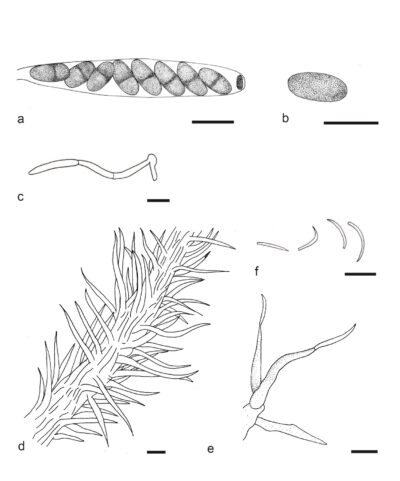Fungalpedia – Note 274, Diatrypasimilis
Diatrypasimilis Jian L. Zhou & Kohlm.
Citation when using this entry: Perera et al. 2024 (in prep) – Fungalpedia, genera described in 2016.
Index Fungorum, Facesoffungi, MycoBank, GenBank, Fig. 1
Classification: Diatrypaceae, Xylariales, Xylariomycetidae, Sordariomycetes, Pezizomycotina, Ascomycota, Fungi
Chalkley et al. (2010) established the monotypic genus Diatrypasimilis with D. australiensis as the type, based on ITS, LSU and SSU markers. Diatrypasimilis australiensis was isolated from the dead intertidal roots of Rhizophora (Chalkley et al. 2010). However, the name D. australiensis was not valid because it was published with the MycoBank identifier MB 515026, which has been already issued for another name. Therefore, the name was effectively published by Suh (2016). The sexual morph of the genus is characterized by thick stroma on the wood surface. The ascomata are black, carbonaceous, erumpent, subglobose, and ostiolate with a conical neck. The hamathecium comprises paraphyses. Asci are 8-spored, cylindrical, unitunicate, with an apical apparatus. The ascospores are uniseriate, ellipsoidal, aseptate, and dark brown with a germ slit (Chalkley et al. 2010). Even though a selenosporella-like, synnemata were formed after 50 d on plugs that grown on freezing agar (potato extract 20% [v/v], glucose 0.8%, yeast extract 0.1%, charcoal 0.05%, agar 2%), the asexual morph characteristics have not been included in the generic description. (Chalkley et al. 2010). Thus, the generic description of the Diatrypasimilis is required to be emended with asexual morph details. The asexual morph of Diatrypasimilis is characterized by indeterminate, synnematal conidiomata that have somewhat parallel stipes and divergent conidiogenous zones. Conidiogenous cells are lageniform to cylindrical and do not have a basal septum. They proliferate either sympodially or annellidically, or sometimes by a combination of both methods, and produce filiform conidia on minute denticles. Conidia are straight to curved, acicular, hyaline and smooth-walled (Chalkley et al. 2010). Diatrypasimilis differs from other genera of Diatrypaceae in ellipsoidal ascospores with a germ slit. Species of Diatrypaceae have allantoid ascospores, which lack germ pores or slits (Chalkley et al. 2010).
Type species: Diatrypasimilis australiensis Jian L. Zhou & Kohlm.
Other accepted species: The genus is monotypic.
Figure 1 – Diatrypasimilis australiensis (a, b: J.K.5329, holotype). a Ascus with refractive apical apparatus. b Ascospore c S-shaped pairs of cells. d Synnema with branching conidiophores and conidia. e Conidiophores with conidia. f Needle-shaped conidia. Scale bars: a, b = 15 μm, c–f = 10 μm. Redrawn from Chalkley et al. (2010)
References
Suh S-O. 2016 – Nomenclatural novelties. Index Fungorum 305, 1–1.
Entry by
Rekhani Hansika Perera, Center of Excellence in Fungal Research, Mae Fah Luang University, Chiang Rai, 57100, Thailand.
(Edited by Kevin D. Hyde, Samaneh Chaharmiri-Dokhaharani, & Achala R. Rathnayaka)
Published online 28 May 2024
